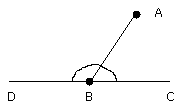If a straight line set up on a straight line make angles, it will make either two right angles or angles equal to two right angles.
 For let any straight line AB set up on the straight line CD make the
angles CBA, ABD;
For let any straight line AB set up on the straight line CD make the
angles CBA, ABD;
 I say that the angles CBA, ABD are either two right angles or equal
to two right angles.
I say that the angles CBA, ABD are either two right angles or equal
to two right angles.

 angle ABD,
they are two right angles.
angle ABD,
they are two right angles.
 But, if not, let BE be drawn from the point B at right angles to CD;
But, if not, let BE be drawn from the point B at right angles to CD;
 therefore the angles CBE, EBD are two right angles.
therefore the angles CBE, EBD are two right angles.
 Then, since the angle CBE is equal to the two angles CBA, ABE
Then, since the angle CBE is equal to the two angles CBA, ABE
 let the angle EBD be added to each
let the angle EBD be added to each
 therefore the angles CBE, EBD are equal to the three angles CBA, ABE, EBD.
therefore the angles CBE, EBD are equal to the three angles CBA, ABE, EBD.
 Again, since the angle DBA is equal to the two angles DBE, EBA
Again, since the angle DBA is equal to the two angles DBE, EBA
 let the angle ABC be added to each
let the angle ABC be added to each
therefore the angles DBA, ABC are equal to the three angles DBE, EBA, ABC.

 But the angles CBE, EBD were also proved equal to the same three angles;
and things which are equal to the same thing are also equal to one another;
therefore the angles CBE, EBD are also equal to the angles DBA, ABC.
But the angles CBE, EBD were also proved equal to the same three angles;
and things which are equal to the same thing are also equal to one another;
therefore the angles CBE, EBD are also equal to the angles DBA, ABC.
But the angles CBE, EBD are two right angles therefore the angles DBA, ABC are also equal to two right angles.
Therefore, etc.
Q.E.D.